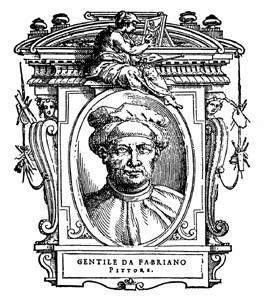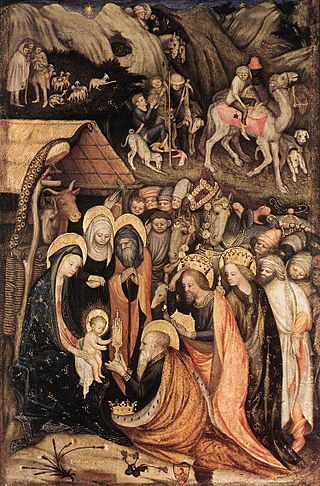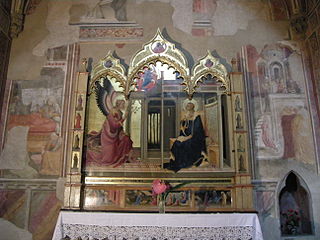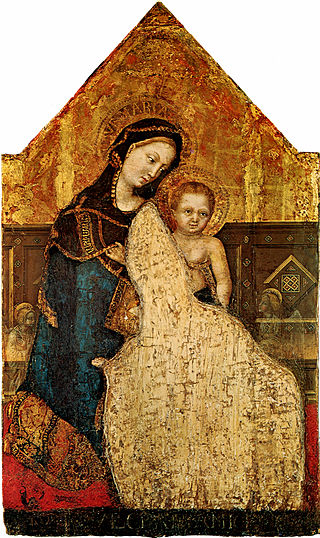Description
The Madonna of Humility, with the Virgin sitting on a cushion over the ground, was a common theme in early 15th century western painting. She is holding the Child on her knees, above a richly decorated gilt cloth. The fine golden background, the rendering of the clothes and other technical detail link the panel to the artist's Florentine period, including works such as the Adoration of the Magi (1423) and (in particular for the posture of the Child) the Adoration of the Child .
A work with the same composition was executed by Gentile da Fabriano in 1420–1421, although in it the Virgin is portrayed frontally.
The mantle of the Virgin has on the border the inscription "AVE M[A]T[ER] DIEGNA [D]EI", while on the edge of the cloth on which the Child lies are Arabic characters, which have been read as the Quran Shahada (لا إله إلا الله - Lā ilāha illa Allāh). The presence of such an element has not been explained, and it could be an exotic addition made without knowing the exact meaning of the original verse.

Fra Angelico, OP was a Dominican friar and Italian painter of the Early Renaissance, described by Giorgio Vasari in his Lives of the Artists as having "a rare and perfect talent". He earned his reputation primarily for the series of frescoes he made for his own friary, San Marco, in Florence, then worked in Rome and other cities. All his known work is of religious subjects.

Jacopo Bellini was one of the founders of the Renaissance style of painting in Venice and northern Italy. His sons Gentile and Giovanni Bellini, and his son-in-law Andrea Mantegna, were also famous painters.

Gentile da Fabriano was an Italian painter known for his participation in the International Gothic painter style. He worked in various places in central Italy, mostly in Tuscany. His best-known works are his Adoration of the Magi from the Strozzi Altarpiece (1423), and the Flight into Egypt. Following a visit to Florence in the 1419, he came in contact with humanism, which influenced his work throughout the rest of his career. He became highly influential for other painters in Florence, especially because of his use of detail based on the observations he made of the natural world.

International Gothic is a period of Gothic art which began in Burgundy, France, and northern Italy in the late 14th and early 15th century. It then spread very widely across Western Europe, hence the name for the period, which was introduced by the French art historian Louis Courajod at the end of the 19th century.

Vincenzo Foppa was an Italian painter from the Renaissance period. While few of his works survive, he was an esteemed and influential painter during his time and is considered the preeminent leader of the Early Lombard School. He spent his career working for the Sforza family, Dukes of Milan, in Pavia, as well as various other patrons throughout Lombardy and Liguria. He lived and worked in his native Brescia during his later years.

Giovanni di Paolo di Grazia was an Italian painter, working primarily in Siena, becoming a prolific painter and illustrator of manuscripts, including Dante's texts. He was one of the most important painters of the 15th century Sienese School. His early works show the influence of earlier Sienese masters, but his later style was more individual, characterized by cold, harsh colours and elongated forms. His style also took on the influence of International Gothic artists such as Gentile da Fabriano. Many of his works have an unusual dreamlike atmosphere, such as the surrealistic Miracle of St. Nicholas of Tolentino painted about 1455 and now housed in the Philadelphia Museum of Art, while his last works, particularly Last Judgment, Heaven, and Hell from about 1465 and Assumption painted in 1475, both at Pinacoteca Nazionale (Siena), are grotesque treatments of their lofty subjects. Giovanni's reputation declined after his death but was revived in the 20th century.
Domenico di Bartolo, born in Asciano, Siena, was a Sienese painter who became active during the early Renaissance period. He was inaccurately named by the famous painter, writer and historian Giorgio Vasari as the nephew of well-reputed Italian artist Taddeo di Bartolo, who is featured in Vasari's Lives of the Most Excellent Painters, Sculptors, and Architects. By the early 1400s, Domenico di Bartolo was one of Siena's artists most influenced by the new Florentine style of painting. During the time that he was active and working, Domenico was the only Sienese painter to have received commissions by clients in Florence. Domenico was also employed by Lorenzo Vecchietta, otherwise referred to as Lorenzo di Pietro, to work alongside him for the fresco The Care of the Sick, which is today considered a masterpiece of the Pilgrim's Hall in the hospital Santa Maria della Scala (Siena).

The Adoration of the Magi is a painting by the Italian painter Gentile da Fabriano. The work, housed in the Uffizi Gallery in Florence, Italy, is considered his finest work, and has been described as "the culminating work of International Gothic painting".

Jacobello del Fiore was a Venetian painter in the late fourteenth century and early fifteenth century. His early work is in the Late Gothic style popularized by Altichiero da Verona and Jacopo Avanzi, two of his contemporaries, while his mature work displays a local Venetian style established by the school of Paolo Veneziano, an artist and workshop proprietor with notable Byzantine inspiration in his work. This stylistic return to his roots sets him apart from Niccolò di Pietro and Zanino di Pietro, Venetian contemporaries he is often associated with. During his lifetime, he received commissions primarily on the Adriatic coast and in Venice.
The decade of the 1420s in art involved some significant events.

Pseudo-Kufic, or Kufesque, also sometimes pseudo-Arabic, is a style of decoration used during the Middle Ages and the Renaissance, consisting of imitations of the Arabic Kufic script, or sometimes Arabic cursive script, made in a non-Arabic context: "Imitations of Arabic in European art are often described as pseudo-Kufic, borrowing the term for an Arabic script that emphasizes straight and angular strokes, and is most commonly used in Islamic architectural decoration". Pseudo-Kufic appears especially often in Renaissance art in depictions of people from the Holy Land, particularly the Virgin Mary. It is an example of Islamic influences on Western art.

The Adoration of the Magi is a Gothic painting by Stefano da Verona. Dating to 1434, it is now in the Pinacoteca di Brera of Milan, northern Italy.

The Bartolini Salimbeni Annunciation is a painting by the Italian Gothic painter Lorenzo Monaco, completed just before his death (1420–1424) and housed in the Bartolini Salimbeni Chapel of the church of Santa Trinita, Florence, Italy.

The Adoration of the Christ Child is a tempera and gold on panel painting by the Italian late medieval artist Gentile da Fabriano, dating from around 1420–1421 and housed in the Getty Center of Los Angeles, United States.

The Pisa Altarpiece was a large multi-paneled altarpiece produced by Masaccio for the chapel of Saint Julian in the church of Santa Maria del Carmine in Pisa. The chapel was owned by the notary Giuliano di Colino, who commissioned the work on February 19, 1426 for the sum of 80 florins. Payment for the work was recorded on December 26 of that year. The altarpiece was dismantled and dispersed to various collections and museums in the 18th century, but an attempted reconstruction was made possible due to a detailed description of the work by Vasari in 1568.

Madonna and Child is a tempera and gold on panel painting by Gentile da Fabriano, executed c. 1424, now in the Yale University Art Gallery in New Haven. It is signed on the left jamb "Gent / Fabriano". Previously traditionally dated to 1420–1423, the new accepted dating is based on similarities between the background architecture and the north door of the Florence Baptistery, completed by Lorenzo Ghiberti in 1424.

Madonna and Child is a tempera and gold on panel painting by Gentile da Fabriano, executed c. 1420–1423, now in the National Gallery of Art in Washington, D.C. The work is generally identified as one of the first the artist produced in Florence, where he had arrived in summer 1420, at roughly the point at which he was working on the Pala Strozzi. It may have been the central panel of a polyptych, the rest of which is now lost.

The Velletri Madonna is a tempera and gold on panel painting by Gentile da Fabriano, executed c. 1426-1427, the only surviving work from his stay in Rome. A Madonna of humility, it was in the church of Santi Cosma e Damiano until 1633 when Ludovico Ciotti di San Paolo, General of the Third Order Franciscans, donated it to the Church of Sant'Apollonia in Velletri. It is now in the Diocesan Museum in Velletri. A restoration in 1912 restored the top to its original triangular form.

Madonna and Child with Saints Julian and Lawrence is a c. 1423–1425 tempera and gold leaf on panel painting by Gentile da Fabriano. It is now in the Frick Collection in New York. To the left is saint Lawrence in a deacon's dalmatic and holding the gridiron of his martyrdom, whilst to the right is Saint Julian.

The Intercession Altarpiece is a five-panel tempera and gold on panel painting by Gentile da Fabriano, produced during his stay in Florence from 1420 to 1423. Its original location is unknown, though it is now in the sacristy of Chiesa di San Niccolò Oltrarno in Florence. It is named after its central panel of Jesus and the Virgin Mary interceding to God the Father. The two outermost panels show Louis of Toulouse and Bernard of Clairvaux. The two inner side-panels show the Resurrection of Lazarus and a group of three saints.


















